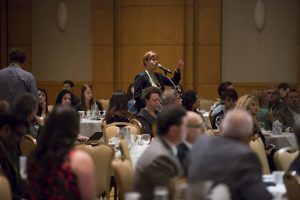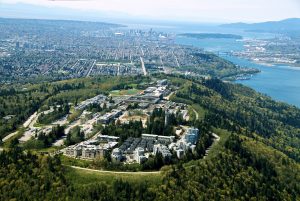
What does “urban resilience” and sustainability mean?
September 27, 2016
By Rosalind Cairncross, P.Eng.
A panel at the SBE16T Conference in Toronto explores some interesting examples, such as the benefits of medium height buildings in natural disasters.

Question period during a session at SBE16Toronto.
The word “resilience” is often tossed about, but what exactly does it mean when applied to the living environment? Last week, speakers at the Sustainable Built Environment Conference of the Americas, SBE16Toronto, offered some definitions with interesting examples.
In a panel discussion on September 20, Lloyd Alter of Ryerson University, favoured the Goldilocks approach – not too high, not too low, just right – the “missing middle” in terms of building height, to create medium density communities. During the Hurricane Sandy flooding, simpler lower buildings of around six storeys proved more resilient. They were back in operation within weeks instead of months for high rise buildings. Medium height buildings offer several advantages including a far better chance of surviving a heart attack.
Alter also favours wood construction. During power failures, he said, the rise or fall in temperature in glass buildings is steep compared with wood. His prescription for resilience and sustainability includes accommodating demographic changes for those who need affordable housing. It proposes passive house standards, a mix of uses, low rise buildings with courtyards, and transit with more stops.
Antonio Gomez-Palacio, principal at Dialog, focused on community planning, and in approaching resilience with slow stresses in mind, like shifts in demographics or the economy, not just the dramatic big events. To him success means prevention plus recovery, not the failure of structures but how the people fared. If the power fails, people on the upper floors of high buildings may not only be too hot or cold but also be unable get food. He defines community resilience as the ability to creatively and collaboratively adapt, respond and recover when change happens. His example was Moncton which has planned its way out of its boom and bust cycles to become a more resilient, award-winning community.

UniverCity at Simon Fraser University, Vancouver. Image: UniverCity
Gordon Harris of SFU Community Trust presented an example of applied sustainability and resilience principles in action. UniverCity, a project of Simon Fraser University in Vancouver, set out to build a model sustainable community for faculty and staff. Its buildings adhere to the “missing middle” principles of 20 storeys or less, it caters to small households, and it incorporates legal secondary units with passive house standards. There are common spaces, retail units, an elementary school and a childcare centre integrated with the university’s education faculty. The community sits on 160 acres on a hilltop and has numerous sustainability features: transit by bus, car share and cable car, green roofs, comprehensive stormwater management, porous pavers, a district energy plant and public art. It is a living laboratory for resilience.
Craig Applegath of Dialog and Jeff Schnurr of Community Forests International moved the discussion to the forest. In an effort to change humanity from a parasitic species to a symbiotic one, they focused on trees. Schnurr had been helping communities restore their forests in Tanzania. This led to the partnership to do the same in New Brunswick. They set about restoring the forest for carbon storage, with selective logging for income. In the process they were able to restore a clearcut and get clearcut rights removed in perpetuity.
Resilience and sustainability are concepts which are evolving as careful thought and practice move forward. The need and the urgency increases with every new disaster.
Rosalind Cairncross, P.Eng., is an editorial advisor and contributing editor with Canadian Consulting Engineer magazine.